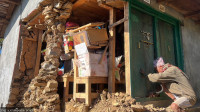Opinion
How to grow
The need of the hour is to focus on each growth-driving sector to create significant traction and ramp up the economy
Sourajit Aiyer
Nepal is at an interesting juncture with the new government in place. Earthquakes and political issues kept economic growth moderate in recent years, and it is now imperative to draw up a policy blue-print for economic revival. If Nepal wants its economy to grow from the current $24 billion to $75 billion by 2025, it would have to target a stellar 15 percent compound annual growth rate (CAGR). That may sound daunting, but nations like China, Malaysia and Thailand aimed for decadal double-digit growth in the initial years of their growth-journey. Even India’s Maharashtra state announced a vision of a 15 percent CAGR. A high yet achievable target pushes the commitment from politicians to realise the economic agenda. But to what extent should Nepal focus on each growth-driver to realise this target of $75 billion? This is what we explore here.
Services-sector: Services constitute 58 percent of Nepal’s nominal gross domestic product (GDP). The average contribution of services to the GDP in most emerging markets has been 60 to 70 percent.
So if services have to constitute 65 percent of Nepal’s GDP by 2025, this sector would have to grow at a 17 percent CAGR going forward, higher than the 15 percent estimated GDP growth. While tourism should remain a policy priority as the main contributor to GDP within the services-sector, deepening the services-sector through the digital economy would bring in efficiencies in public-services delivery, bring more citizens into its organised economy and reduce the leakages of a cash-based economy. It would also ensure the delivery of subsidies to the intended recipients. All these would expand its addressable consumer-base and purchasing-power. Services include ramping up the quality of skill-centres to improve productivity and employment prospects. Nepal has already started skill certifications in this area.
Industry-sector: 13 percent of Nepal’s nominal GDP is estimated to come from the industry-sector, far less than the average 35 percent seen in most emerging markets. Nepal would need to push this sector to make up for the lag. So if Nepal’s industry has to contribute 18 percent of the GDP, which would be half of the global-average, it would have to grow at a stellar 20 percent CAGR going forward. Nepal’s gross investment has been 40 percent of the GDP in recent years, in line with China and Southeast Asia in their initial years of industrialisation. But this investment was used more for post-earthquake rebuilding and was used less as incremental fixed capital in the industrial sector. If Nepal continues to hold the share of investment at 40 percent to push industry now, its investment has to grow at a 14 to15 percent CAGR, in line with its estimated GDP growth. Investment correlates with productive imports like machinery. In Nepal, imports comprised 42 percent of the GDP, which was the same as its share of investment. Recent industrialising nations have seen their share of imports to be 50 to 60 percent of their share of investment. This implies part of Nepal’s imports was for non-productive purposes. Imports have to be reduced. If imports grow at only seven percent CAGR, its share can dip to 25 percent by 2025 (i.e. 60 percent of the share of investment, estimated at 40 percent of the GDP). Where should investment go? Nepal needs more affordable housing, urban transport and industry clusters in underdeveloped regions outside the Kathmandu Valley. But this would also mean addressing the Ease of Doing Business parameters, where Nepal lost its rank by six places in the last two years.
Agriculture-sector: Thirty percent of Nepal’s GDP is estimated to come from agriculture, amongst the highest globally. Most emerging markets saw a sub-10 percent share. The crux is to improve farm-productivity, as agriculture employs more than 70 percent of its workforce. If Nepal has to reduce its share of agriculture by half to amount to 15 percent of the GDP, it has to grow at a six to seven percent CAGR, and growth has to be backed by productivity improvement. Labour must be re-skilled for high-growth sectors like construction, trade and retail. It also means investing in irrigation and market linkages to improve yield and ensure the farmer gets the correct price. So some incremental investment has to flow into the agro-sector too.
Export-sector: Only 10 percent of Nepal’s GDP is estimated to come from exports. Exports have to grow at a rapid 30 percent CAGR going forward, if it has to meet the Forex demand for imports and keep the trade imbalance nil. The issue is that the Nepali Rupee has gained against the US Dollar in the last year, while the Bangladesh Taka, Sri Lankan Rupee and Pakistani Rupee (which is used to export common products like food and materials) fell. This makes it all the more imperative for Nepal to draw up Free Trade Agreements and export-promotion schemes with new partner countries. It should also push services-sector export and not rely only on merchandise export.
Consumption-sector: Nepal has a high share of private consumption to GDP at 76 percent versus the average 60 percent in most emerging markets. Tanzania and Uganda have a similar per-capita, but they spend less and save more. Over-dependence on external borrowing is not healthy, as it has collateral implications. Nepal needs to ramp up its savings rate further by energising its domestic financial sector with more products, assets, talent and regulations.
All in all, these segmental growth-estimates to target a GDP of $75 billion by 2025 may sound over-ambitious. But it is not unachievable. Ramping up industry, investment, export and saving can create significant traction in the long-term!
Aiyer is an author and financial services professional, and researches for South Asia Fast Track




 11.12°C Kathmandu
11.12°C Kathmandu










